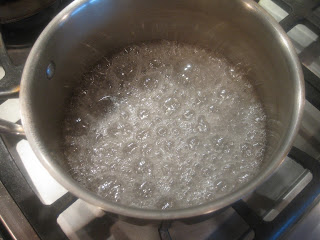I made this to use the butternut squash that I had roasted and mashed; adding bacon and ricotta cheese just seemed right. Fresh sage and provolone cheese rounded out the dish, which was hot, cheesy and creamy, eaten straight from the oven.
This is a great use for leftover squash of any kind.
I used pasta shells, but any pasta shape that will hold up to a thick, creamy sauce will work...penne, rigatoni, orechiette. This dish does not have to be baked, it can be eaten right away, but we like the golden, crispy cheese that you get when you bake it.
Cook enough pasta for 4 people, about 500g. While the pasta is cooking, you can make the sauce. Heat the oven to 350F and have an ovenproof dish ready.
Cook over medium-low heat:
4 rashers of bacon, diced
4 - 5 leaves fresh sage
When the bacon has released its fat, and is cooked, but not crispy, add:
1/2 medium onion, diced
Cook until the onion has softened, and the bacon starts to get crispy.
Stir in:
3 tablespoons flour
1/4 teaspoon ground black pepper
and cook for 2 - 3 minutes
Whisk in:
1 cup milk
Bring to a boil, whisking to prevent lumps.
Remove from the heat.
In a large bowl, combine:
the bacon sauce
1 cup ricotta cheese
1 cup cooked, mashed butternut squash
Taste and adjust seasoning.
Stir in:
16 cloves roasted garlic
Combine the sauce with the cooked, drained pasta.
Scrape the pasta and sauce into the ovenproof dish, and sprinkle grated provolone cheese over the top.
Bake until the pasta is hot and bubbling, and the cheese is melted and golden.
Serve immediately....
- Leftover squash of any kind can be used....butternut, pumpkin, acorn, hubbard or any other winter squash. If the squash has been cooked with herbs and/or spiced this will add to the flavour of your pasta sauce.
- The bacon is optional; I used it for the smokiness. It also adds salt, so that is the reason I only added pepper until the end when I tasted and adjusted the seasoning.
- Sage is a herb that I associate a lot with Fall cooking, and it is perfect with squash. Other herbs can be used...thyme, rosemary or oregano.
- I used ricotta cheese, but cottage cheese can be used if that is what you have.
- I had roast garlic left from another meal; it can be omitted, but it does add a lot to the dish, and is worth roasting ahead of time to include. See the post Garlic for how to roast garlic.
- Any melting cheese is suitable for the top; try combining breadcrumbs, cheese and chopped fresh herbs for a crunchier topping. Provolone is slightly tangier and sharper than mozzarella.
- If you choose not to bake the pasta, add the ricotta and squash to the bacon sauce and heat it through before adding it to the hot pasta. Sprinkle grated Parmesan on top to serve.
- The pasta and sauce can be frozen; defrost before baking. It can also be assembled a day ahead, and kept well covered in the fridge before baking.




























































